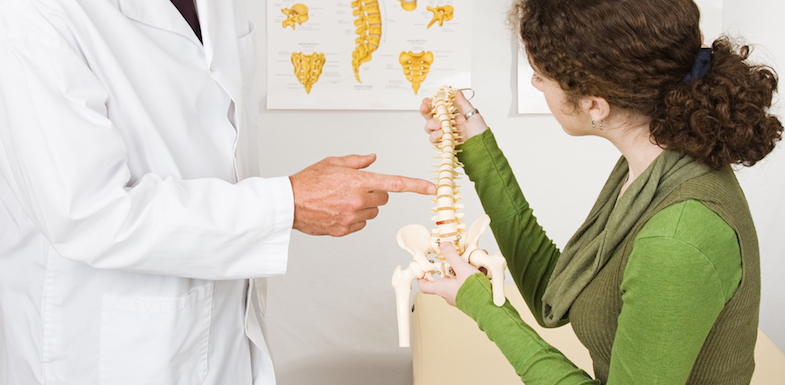
The importance of a strong, healthy, aligned spine cannot be underestimated. It supports our entire body and easy movement through our day. If you are considering visiting the chiropractor for an acute injury or an old pain that just won’t go away, here’s how chiropractic care works (and how it could help you).
What is chiropractic care?
Chiropractic care focuses on aligning your spine to ensure proper function of all of the joints in your body as well as a coordinated, healthy nervous system. It’s a whole-body treatment that considers the whole patient versus only one area.
To start, your spine contains 33 vertebrae, all of which are separated by thin, cushioned intervertebral discs. Each bone also connects to its neighbors by facet joints. The whole spine protects your spinal cord and the nerves that emerge from it.
When the spine is misaligned, your whole body feels “off.” Chiropractic care addresses any shifts in this crucial support system to bring back a feeling of wellness with less (or no) medications or surgery.
Chiropractors receive specialized training. They focus on preventing, diagnosing, and healing disorders of the spine and other joints. Chiropractic care takes a holistic approach, incorporating other treatment modalities like soft tissue manipulation, lifestyle changes, and changes to nutrition.
How does chiropractic care work?
There are an estimated 200 or more chiropractic techniques, with many of them being minor variations on the main techniques. They vary in terms of pressure applied and positioning of the patients.
The most common chiropractic techniques, which we will explain below, include:
- Diversified technique
- Extremity manipulating and adjusting
- Spinal mobilization
- Myofascial release
- Indirect positional technique
- Palmer upper cervical adjustment
- Functional technique

Diversified technique
This chiropractic technique, also referred to as direct thrust or spinal manipulation, involves applying high-velocity, low-amplitude force to a targeted area of the spine.
Some people refer to this as “back cracking,” but there is more to it than that. The chiropractor takes care to evaluate where the force should be applied before moving the joint into the correct place. When the joint moves, gas that has been trapped can sometimes burst, causing a popping or cracking sound. This is normal and not harmful.
The diversified technique encourages proper spinal alignment and is the most common type of chiropractic adjustment performed.
Extremity manipulating and adjusting
Articulatory chiropractic adjustments work to restore free movement in your joint. In other words, they help restore your full range of motion.
To perform this technique, your chiropractor will move each arm, leg, or other extremity through its range of motion while applying gentle force to improve mobility.
Spinal mobilization
Spinal mobilization has a goal similar to the diversified technique but is used for patients who require a gentler approach.
Instead of a fast thrust, chiropractors apply slow, steady, and firm pressure to your spine. This brings it back to alignment and promotes optimal function and movement.
Myofascial release
The fascia is a thin webbing that encloses all of the muscles of your body. It even weaves its way through the muscles and around the joints. When this webbing become tight, strained, or injured, it can constrict movement and change the alignment of your spine.
Myofascial release finds these stiffened trigger points and a chiropractor then applies steady pressure to encourage them to release. This allows the joints of your body to move more freely and can help relieve pain and tension in the muscles.
Indirect positional technique
The indirect positional technique works best for people who find themselves with hypertonic muscle development. This is when one set of muscles is overdeveloped, with a corresponding set of muscles that lack development. This lack of balance can cause misalignment and pain in the entire body.
To correct this imbalance, your chiropractor moves the affected joint into a neutral position before applying targeted force aimed at releasing the hypertonic muscle and restoring the joint’s full range of motion.
For example, for people who work at a computer or hunch over a steering wheel all day, this technique can release the pectoral muscles and correct the rounded shoulders that can cause pain in the upper back.
Palmer upper cervical adjustment
As chiropractic care was invented in the 19th century by DD Palmer, it seems only fitting that one of the most common chiropractic techniques is named after its founder.
This technique uses low-amplitude, high velocity thrusts (or the more gentle positional technique for those who need it) to restore alignment specifically in the cervical spine (the neck).
Functional technique
Functional technique borrows from myofascial release to restore a joint’s range of motion.
Your chiropractor will move the targeted joint until it comes to a stop, then apply gentle pressure until it begins to release.
What tools does a chiropractor use?
In addition to the hands-on adjustments above, many chiropractors will also utilize handheld devices or specialized tables and pads to help restore alignment in your spine.
The most common of the handheld tools is the activator adjustment tool. The activator is a small handheld and spring-loaded instrument that falls into the category of mechanical force manual assisted (MFMA) instruments. The device sends a small impulse to the spine. This impulse is strong enough to adjust the vertebra but not to injure the body.
Another handheld tool that uses electrical impulses to apply pain-free force for adjusting is appropriately called the electronic impulse adjusting instrument. For patients who struggle with the normal and harmless popping and cracking sounds of manual adjustments, this instrument replaces the sound with a light tapping sensation.
Chiropractors also use tables like a decompression table or a drop table to assist with traction or provide additional force to adjust the spine. The gravity of a drop table adds extra force to a targeted area of the spine while comfortably supporting the body. They also use special tables for pregnant patients or those with other mobility issues.
Whether chiropractors use hands-on spinal manipulation techniques or specialized tools depends on each patient and their specific needs. Chiropractors train in a variety of methods and diagnostic tools to help them decide which will work best for you. You can see a live demonstration of these tools and techniques in the following video.
Does chiropractic care work?
Chiropractic care has suffered in the past from a lack of proper research funding until the early 2000s when interest in this practice began to rise due to its side-effect free potential for real pain relief.
Since then, there have been a variety of scientifically-valid studies to support its efficacy for many conditions.
Lower back pain
The most promising research has been in the area of lower back pain, the most common and disabling type of pain in the U.S.
A 2010 study validated chiropractic care’s effectiveness in relieving lower back pain, a study that was confirmed by additional research in 2011 and again in 2018.
Neck pain
A randomized trial in 2012 found that chiropractic care was as effective as prescription pain medication and neck mobilization in treating neck pain.
In 2016, another study found that chiropractic care for neck pain was effective in terms of pain relief and as a more affordable health care option.
Migraine
In 2011, a review of available studies showed that migraine patients could expect some improvement with chiropractic care for their migraines. While the improvement in these studies was listed as “moderate,” it is important to remember that chiropractic care does not have the side effects that come with most prescription migraine medications.
While anecdotal evidence of pain relief is strong, there is an ongoing call for more studies into the efficacy of chiropractic care for migraines.
Who could benefit most from chiropractic care?
While chiropractic treatment is most frequently sought for lower back pain, neck pain, and migraines, there are other conditions that research suggests may be helped with chiropractic care. These include:
- Scoliosis
- Sciatica
- Acute injuries (e.g., from car accidents or sports)
- Fibromyalgia
- Muscles tension and stress
- Chronic pain
- General subluxation (misalignment in the spine)
It’s important to note that chiropractic care is just one part of a comprehensive treatment plan for these conditions. The best way to treat these complicated medical conditions is with a holistic approach. This may include lifestyle changes to diet, activity level, and habits (e.g., smoking and alcohol consumption). A chiropractor treats the whole person and helps you strengthen your overall health.
Frequently asked questions about chiropractic care
Finally, we know that the idea of moving your bones around can be intimidating. Here are some answers to questions you might still have about this treatment approach.
Our team at Arizona Pain is also always available to discuss any questions you have.
How often should you get chiropractic adjustments?
Most patients see improvement between six and ten visits. Your doctor will offer specific guidelines on the proper number of treatments for you and their frequency.
In many cases you will receive treatments more frequently during the acute phase of an injury. Treatments occur fewer and farther between as your condition improves.
What to do after chiropractic adjustment?
Other than the possibility of living with less pain after a chiropractic adjustment, one of the best parts about chiropractic care is that there is no recovery time. The vast majority of patients are able to leave their chiropractor’s office and continue about their day.
Some patients may experience minor dizziness directly after an adjustment, but this usually passes quickly. If you are receiving treatment for an acute injury, talk to your chiropractor about additional care after an adjustment to support proper healing and recovery.
Do chiropractic adjustments hurt?
In general, chiropractic adjustments do not hurt. Some patients do not like the popping sound of air bubbles releasing during their adjustment. For the most part, though, this is painless.
The pressure and manipulation of the joints may not be comfortable while it is happening. After your joint releases, though, you shouldn’t feel pain.
Are there risks to chiropractic treatments?
Although recognized as very safe, as with all medical procedures, there are a few rare risks with chiropractic treatment.
Some patients with herniated or bulging discs may see a worsening of their condition. This could lead to a serious condition called equina cauda syndrome. In very rare instances, cervical adjustments can lead to a type of stroke called a vertebral artery dissection.
It’s important to talk to your doctor about your potential risks before receiving treatment.
Is there anyone who is not a good candidate for chiropractic care?
People who have severe osteoporosis or cancer in the spine are not good candidates for chiropractic care.
Additionally, if you regularly experience numbness, tingling, or weakness in the extremities, you may need to seek treatment to diagnose the cause of that prior to treatment.
Finally, due to the increased risk of stroke in cervical adjustments, if have already had a stroke or are at an increased risk of one, chiropractic care may not be right for you.
Learn more about chiropractic care
If you are looking for compassionate chiropractic care, come visit the chiropractors of Arizona Pain. With convenient locations across the Phoenix Valley and a commitment to comprehensive treatment plans, we can help you get your life back.